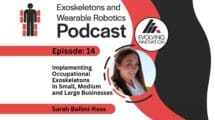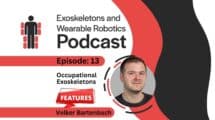Nicolas Rojas has created an exoskeleton hand primarily for stroke survivors. This exoskeleton has 12 degrees of freedom and it uses just one motor and a bar linkage. The Exo-Hand mechanism can be fully customized and tailored for every patient for comfort while retaining efficiency. The mechanical glove can run independently for 1.5-2 hours in continuous use mode, which is already sufficient considering that most rehabilitation sessions last about one hour. Most patients using the Exo-Hand should be able to achieve hand flexion and extension without a problem.
The Exo-Hand is a personal project that has been in development by Nicolas since he graduated from university. The project goal is to create a company, but first, the exoskeleton glove has to become affordable as possible. According to Nicolas, stroke survivors in Colombia just don’t have enough resources to access the best technology out there.
The device has already been tested with patients for durability and performance. The users showed qualitative improvements on their hand functionality. Technically the project is going well, but Nicolas does not have the financial support to keep up the development effort.
The last statement is challenging to reconcile. Exoskeleton companies in first world countries, even those in the middle of a technological research hub such as the San Francisco Bay Area have found it challenging to acquire funding, but there is always a sense of optimism that investment funds will be found. But what is it like to develop exoskeletons in countries with less investment capital, such as AxoSuits in Romania or the Jaipur Belt being developed for workers in India? I decided to go straight to the source and ask Nicolas Rojas to shed some light on the challenges of developing exoskeletons outside first world countries:
Bobby – Could you talk about what it is like developing an exoskeleton in a country with fewer resources?
Nicolas – It is quite difficult to develop an exoskeleton in a country like Colombia, not only because there isn’t much support on the technology area but because there isn’t support in pretty much any other area. The healthcare here is horrible and the government doesn’t help much. Most of the stroke survivors and I am sure that most of the people with disabilities here in Colombia struggle a lot to get rehabilitation therapies because of the poor healthcare services.
It is also difficult to get resources, economical and also material. Around half of the materials have been imported in order to make the exoskeleton because you can’t buy them here or they are too expensive. But there is a really good thing about developing an exoskeleton in a country like Colombia and that is that you start being really recursive and creative with the things you have around.
Bobby -Do you feel that Colombia is being left behind because of the prohibitive cost of exo development?
Nicolas – In a certain way, yes but I think this is happening in the whole world, right now the cost of exoskeletons is too high for normal people and even higher for developing countries. That is why I am trying to keep the costs of the exoskeleton to a minimum, in order to reach as many people as I can and at the same time offering them a good quality product.
I think governments have to be more involved in these types of projects, what we are trying to do with exoskeletons is to help disabled people to have a better quality of life or regain their quality of life they had before and I think that is a vital part of the governments’ job.
Special thanks to Nicolas Rojas for taking the time to share his exoskeleton project with us. From his account, we can see that countries that can benefit from medical and injury prevention exoskeletons are hindered in developing the devices internally. Potentially, a pair of rehabilitation professionals can supervise the use of a dozen Exo-Hand like devices, making at least a few hand rehabilitation exercises more accessible and affordable than ever before in Colombia.








Hello,
This case is very inspiring to me.
I’m Brazilian and i would like to talk with you Nicolas, about the challenges and possibilities in sul-american countries.
Thank you!
It also have some advantages like low cost living and development, that can impact seriously in the final price that the user pay.
With relatively little money you can do much more than in expensive countries.
Regards from Mexico.